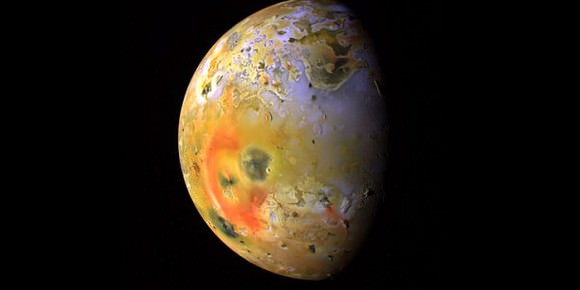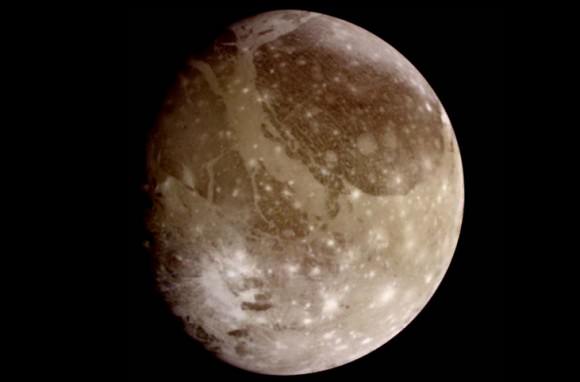It’s no accident that Jupiter shares its name with the king of the gods. In addition to being the largest planet in our Solar System – with two and a half times the mass of all the other planets combined – it is also home to some of the largest moons of any Solar planet. Jupiter’s largest moons are known as the Galileans, all of which were discovered by Galileo Galilei and named in his honor.
They include Io, Europa, Ganymede, and Callisto, and are the Solar System’s fourth, sixth, first and third largest satellites, respectively. Together, they contain almost 99.999% of the total mass in orbit around Jupiter, and range from being 400,000 and 2,000,000 km from the planet. Outside of the Sun and eight planets, they are also among the most massive objects in the Solar System, with radii larger than any of the dwarf planets.
Discovery:
The Galileans take their name from Galileo Galilee, the famous Italian astronomer who discovered them between January 7th and 13th, 1610. Using his improved telescope, which he designed himself, he observed what he described at the time as “three fixed stars, totally invisible by their smallness”. All three of these luminous objects were close to Jupiter, and lay on a straight line through it.
Subsequent observations showed that these “stars” changed position relative to Jupiter, and in a way that was inexplicable as far as the behavior of stars was concerned. On January 10th, Galileo noted that one of them had disappeared, an observation which he attributed to it being hidden behind Jupiter. Within a few days, he concluded that they were orbiting Jupiter and were in fact moons.

By January 13th, he had discovered a fourth moon, and named them the Medicean stars, in honor of his future patron – Cosimo II de’ Medici, Grand Duke of Tuscany – and his three brothers. However, Simon Marius – a German astronomer who also claimed to have found these four moons – prescribed the names Io, Europa, Ganymede and Callisto (after Zeus’ lovers in the Greek mythology) in 1614.
While these names fell out of favor for many centuries, they became commonplace by the 20th century. Together, they also became known as the Galileans, in honor of their discoverer.
Io:
The innermost is Io, which is named after a priestess of Hera who became Zeus’ lover. With a diameter of 3,642 kilometers, it is the fourth-largest moon in the Solar System. With over 400 active volcanoes, it is also the most geologically active object in the Solar System. Its surface is dotted with over 100 mountains, some of which are taller than Earth’s Mount Everest.

Unlike most satellites in the outer Solar System (which are covered with ice), Io is mainly composed of silicate rock surrounding a molten iron or iron sulfide core. Io has an extremely thin atmosphere made up mostly of sulfur dioxide (SO2).
Europa:
The second innermost Galilean moon is Europa, which takes its name from the mythical Phoenician noblewoman who was courted by Zeus and became the queen of Crete. At 3121.6 kilometers in diameter, it is the smallest of the Galileans, and slightly smaller than the Moon.
Europa’s surface consists of a layer of water surrounding the mantle which is thought to be 100 kilometers thick. The uppermost section is solid ice, while the bottom is believed to be liquid water, which is made warm due to heat energy and tidal flexing. If true, then it is possible that extraterrestrial life could exist within this subsurface ocean, perhaps near a series of deep-ocean hydrothermal vents.
The surface of Europa is also one of the smoothest in the Solar System, a fact which supports the idea of liquid water existing beneath the surface. The lack of craters on the surface is attributed to the surface being young and tectonically active. Europa is primarily made of silicate rock and likely has an iron core, and a tenuous atmosphere composed primarily of oxygen.
Ganymede:
Next up is Ganymede. At 5262.4 kilometers in diameter, Ganymede is the largest moon in the Solar System. While it is larger than the planet Mercury, the fact that it is an icy world means that it has only half of Mercury’s mass. It is also the only satellite in the Solar System known to possess a magnetosphere, likely created through convection within the liquid iron core.
Ganymede is composed primarily of silicate rock and water ice, and a salt-water ocean is believed to exist nearly 200 km below Ganymede’s surface – though Europa remains the most likely candidate for this. Ganymede has a high number of craters, most of which are now covered in ice, and boasts a thin oxygen atmosphere that includes O, O2, and possibly O3 (ozone), and some atomic hydrogen.



Mr Williams, this comment is intended as (about) much as constructive criticism as just ripping.
While reading your article “A Universe of 10 Dimensions” I noticed some careless errors that, to me, don’t befit writers in general and certainly not writers for science oriented websites.
“Beyond these three visible dimensions, scientists believe that *there may* many more.”
“The existence of these additional six dimensions which we cannot perceive is necessary for String Theory in order for *their* to be consistency in nature. ”
Everyone makes mistakes, but perhaps you’d want to be wary of these in future writings.
Good day to you